Relating Hydrodynamic Forcing and Topographic Response for Tide-Dominated Sandy Beaches
Abstract
1. Introduction
2. Materials and Methods
2.1. Study Area
2.2. Measuring Campaigns
2.3. Measurements of Hydrodynamics and Sediment Concentrations
2.4. Measurements of Beach Topography
2.5. Relating Forcing and Response: Principal Component Analysis
3. Results
3.1. Hydrodynamics and Suspended Sediment Concentrations
3.1.1. Current Direction
3.1.2. Natural Sediment Supply to the Beach
3.2. Beach Topography
3.3. The Relation between Hydrodynamics, Suspended Sediment Concentration, and Beach Topography
4. Discussion
4.1. Effect of Tide on the Beach Topography
4.1.1. Relative Tidal Range
4.1.2. Bed Shear Stress
4.1.3. Current Direction
4.2. Sediment Supply to the Beach
4.3. Summary of the Observed Intertidal Beach Morphodynamics
5. Conclusions
Author Contributions
Funding
Acknowledgments
Conflicts of Interest
Appendix A

Appendix B
References
- Aagaard, T.; Kroon, A.; Andersen, S.; Sørensen, R.M.; Quartel, S.; Vinther, N. Intertidal beach change during storm conditions; Egmond, The Netherlands. Mar. Geol. 2005, 218, 65–80. [Google Scholar] [CrossRef]
- Biausque, M.; Senechal, N. Seasonal morphological response of an open sandy beach to winter wave conditions: The example of Biscarrosse beach, SW France. Geomorphology 2019, 331, 157–169. [Google Scholar] [CrossRef]
- De Vries, S.; Gong, Y.; Hoonhout, B. The Role of Sediment Supply to the Aeolian Coastal Dune System in Contrasting Areas. In Proceedings of the International Conference on Coastal Sediments 2019, Tampa, FL, USA, 27–31 May 2019. [Google Scholar]
- Masselink, G.; Hughes, M.G. Introduction to Coastal Processes and Geomorphology; Oxford University Press Inc: Oxford, UK, 2003. [Google Scholar]
- Meyer, R.D. A Model Study of Wave Action on Beaches. M.S. Thesis in Civil Engineering, University of California, Oakland, CA, USA, 1936. [Google Scholar]
- Sunamura, T.; Horikawa, K. Two-dimensional beach transformation due to waves. In Proceedings of the 14th International Conference on Coastal Engineering, Copenhagen, Denmark, 24–28 June 1974. [Google Scholar]
- Ahrens, J.P.; Hands, E.B. Velocity parameters for predicting cross-shore sediment transport. J. Waterw Port Coast. Ocean. Eng. 1998, 124, 16–20. [Google Scholar] [CrossRef]
- Masselink, G.; Russell, P.; Turner, I.; Blenkinsopp, C. Net sediment transport and morphological change in the swash zone of a high-energy sandy beach from swash event to tidal cycle time scales. Mar. Geol. 2009, 267, 18–35. [Google Scholar] [CrossRef]
- Philips, M.S.; Harley, M.D.; Turner, I.L.; Splinter, K.D.; Cox, R.J. Shoreline recovery on wave-dominated sandy coastlines: The role of sandbar morphodynamics and nearshore wave parameters. Mar. Geol. 2017, 385, 146–159. [Google Scholar] [CrossRef]
- Wright, L.D.; Short, A.D. Morphodynamics variability of surf zones and beaches: A synthesis. Mar. Geol. 1984, 56, 93–118. [Google Scholar] [CrossRef]
- Davis, R.A. Beach and nearshore zone. In Coastal Sedimentary Environments; Davis, R.A., Ed.; Springer: Berlin/Heidelberg, Germany, 1985. [Google Scholar]
- Wright, L.D.; Nielsen, P.; Short, A.D.; Green, M.O. Morphodynamics of a macrotidal beach. Mar. Geol. 1982, 50, 97–128. [Google Scholar] [CrossRef]
- Masselink, G.; Hegge, B. Morphodynamics of meso- and macrotidal beaches: Examples from central Queensland, Australia. Mar. Geol. 1995, 129, 1–23. [Google Scholar] [CrossRef]
- Voulgaris, G.; Simmonds, D.; Michel, D.; Howa, H.; Collins, M.B.; Huntley, D.A. Measuring and Modelling Sediment Transport on a Macrotidal Ridge and Runnel Beach: An Intercomparison. J. Coast. Res. 1998, 14, 315–330. [Google Scholar]
- Sipka, V.; Anthony, E.J. Morphology and hydrodynamics of a macrotidal ridge and runnel beach under modal low wave conditions. J. Rech. Océanographique 1999, 24, 25–31. [Google Scholar]
- Masselink, G.; Pattiaratchi, C. Tidal asymmetry in sediment resuspension on a macrotidal beach in northwestern Australia. Mar. Geol. 2000, 163, 257–274. [Google Scholar] [CrossRef]
- Cartier, A.; Héquette, A. Variation in longshore sediment transport under low to moderate conditions on barred macrotidal beaches. J. Coast. Res. Spec. Issue 2011, 64, 45–49. [Google Scholar]
- Anthony, E.J.; Levoy, F.; Monfort, O. Morphodynamics of intertidal bars on a megatidal beach, Merlimont, Northern France. Mar. Geol. 2004, 208, 73–100. [Google Scholar] [CrossRef]
- Masselink, G.; Short, A.D. The Effect of Tide Range on Beach Morphodynamics and Morphology: A Conceptual Beach Model. J. Coast. Res. 1993, 9, 785–800. [Google Scholar]
- Levoy, F.; Anthony, E.J.; Monfort, O.; Larsonneur, C. Morphodynamics of megatidal beaches in Normandy, France. Mar. Geol. 2000, 171, 39–59. [Google Scholar] [CrossRef]
- Kroon, A.; Masselink, G. Morphodynamics of intertidal bar morphology on a macrotidal beach under low-energy wave conditions, North Lincolnshire, England. Mar. Geol. 2002, 190, 591–608. [Google Scholar] [CrossRef]
- Brand, E.; De Sloover, L.; De Wulf, A.; Montreuil, A.-L.; Vos, S.; Chen, M. Cross-shore Suspended Sediment Transport in Relation to Topographic Changes in the Intertidal Zone of a Macro-Tidal Beach (Mariakerke, Belgium). J. Mar. Sci. Eng. 2019, 7, 172. [Google Scholar] [CrossRef]
- Aagaard, T. Sediment supply to beaches: Cross-shore sand transport on the lower shoreface. J. Geophys. Res. Earth Surf. 2014, 119, 913–926. [Google Scholar] [CrossRef]
- Brand, E.; Chen, M.; Montreuil, A.-L. Optimizing measurements of sediment transport in the intertidal zone. Earth Sci. Rev. 2019, 200, 1–10. [Google Scholar] [CrossRef]
- Beets, D.J.; van der Valk, L.; Stive, M.J.F. Holocene evolution of the coast of Holland. Mar. Geol. 1992, 103, 423–443. [Google Scholar] [CrossRef]
- Stive, M.J.F.; DeVriend, H.J. Modelling shoreface profile evolution. Mar. Geol. 1995, 126, 235–248. [Google Scholar] [CrossRef]
- Cowell, P.J.; Stive, M.J.F.; Roy, S.; Kaminsky, G.M.; Buijsman, M.C.; Thom, B.G.; Wright, L.D. Shoreface sand supply to beaches. In Proceedings of the 27th International Conference on Coastal Engineering (ICCE), Sydney, Australia, 16–21 July 2000. [Google Scholar]
- Van Heteren, S.A.; van der Spek, A.; van der Valk, B. Evidence and implications of middle- to late-Holocene shoreface steepening offshore the western Netherlands. In Proceedings of the Coastal Sediments 2011, Miami, FL, USA, 2–6 May 2011. [Google Scholar]
- Dubois, R.N. Seasonal variation of mid-foreshore sediments at a Delaware beach. Sediment. Geol. 1989, 61, 37–47. [Google Scholar] [CrossRef]
- Brand, E.; Montreuil, A.-L.; Dan, S.; Chen, M. Macro-tidal beach morphology in relation to nearshore wave conditions and suspended sediment concentrations at Mariakerke, Belgium. Reg. Stud. Mar. Sci. 2018, 24, 97–106. [Google Scholar] [CrossRef]
- Short, A.D. Macro-Meso Tidal Beach Morphodynamics–An Overview. J. Coast. Res. 1990, 7, 417–436. [Google Scholar]
- Haerens, P.; Bolle, A.; Trouw, K.; Houthuys, R. Definition of storm thresholds for significant morphological change of the sandy beaches along the Belgian coastline. Geomorphology 2012, 143–144, 104–117. [Google Scholar] [CrossRef]
- Van Oyen, T.; van Lancker, V.; de Swart, H. De Noordzeebodem: Een landschap vol pieken en dalen. Available online: https://www.researchgate.net/publication/294124901_De_noordzeebodem_een_landschap_vol_pieken_en_dalen (accessed on 25 February 2020).
- Houthuys, R. Morfologische trends van de Vlaamse Kust in 2011. In Agentschap Maritieme Dienstverlening en Kust; Afdeling Kust: Oostende, Belgium, 2012. [Google Scholar]
- Deronde, B.; Houthuys, R.; Henriet, J.-P.; van Lancker, V. Monitoring of the sediment dynamics along a sandy shoreline by means of airborne hyperspectral remote sensing and LiDAR: A case study in Belgium. Earth Surf. Process. Landf. 2008, 33, 280–294. [Google Scholar] [CrossRef]
- Pawlowicz, R.; Beardsley, B.; Lentz, S. Classical Tidal Harmonic Analysis Including Error Estimates in MATLAB using T_TIDE. Comput. Geosci. 2002, 28, 929–937. [Google Scholar] [CrossRef]
- Masselink, G.; Hughes, M.G.; Knight, J. Introduction to Coastal Processes & Geomorphology, 2nd ed.; Hodder education: London, UK, 2011. [Google Scholar]
- Suanez, S.; Stéphan, P. Forçages météo-marins et dynamique morphosédimentaire saisonnière des cordons dunaires. Exemple de la baie de Saint-Michel-en-Grève (Côtes d’Armor, Bretagne). Geomorphol. Relief Process. Environ. 2006, 2, 91–110. [Google Scholar] [CrossRef]
- Montreuil, A.-L.; Bullard, J.E.; Chandler, J.H. Detecting seasonal variations in embryo dune morphology using a terrestrial laser scanner. J. Coast. Res. 2013, 65, 1313–1318. [Google Scholar] [CrossRef]
- Fabbri, S.; Giambastiani, B.M.S.; Sistilli, F.; Scarelli, F.; Gabbianelli, G. Geomorphological analysis and classification of foredune ridges based on Terrestrial Laser Scanning (TLS) technology. Geomorphology 2017, 295, 436–451. [Google Scholar] [CrossRef]
- Simmonds, D.J.; O’Hare, T.J.; Huntley, D.A. The influence of Long Waves on Macrotidal Beach Morphology. In Proceedings of the 25th International Conference on Coastal Engineering, Orlando, FL, USA, 2–6 September 1996. [Google Scholar]
- Masselink, G.; Russell, P.; Blenkinsopp, C.; Turner, I. Swash zone sediment transport, step dynamics and morphological response on a gravel beach. Mar. Geol. 2010, 274, 50–68. [Google Scholar] [CrossRef]
- Bartholdy, J.; Aagaard, T. Storm surge effects on a back-barrier tidal flat of the Danish Wadden Sea. Geo Mar. Lett. 2001, 20, 133–141. [Google Scholar] [CrossRef]
- Shields, A. Anwendung der Ähnlichkeitsmechanik und der Turbulenz Forschung auf die Geschiebewegung. Available online: https://repository.tudelft.nl/islandora/object/uuid%3A61a19716-a994-4942-9906-f680eb9952d6 (accessed on 25 February 2020).
- Soulsby, R. Dynamics of Marine Sands; Thomas Telford: London, UK, 1997. [Google Scholar]
- Kobayashi, N.; Payo, A.; Schmied, L. Cross-shore suspended sand and bed load transport on beaches. J. Geophys. Res. Oceans 2008, 113, C07001. [Google Scholar] [CrossRef]
- Reichmüth, B.; Anthony, E.J. Tidal influence on the intertidal bar morphology of two contrasting macrotidal beaches. Geomorphology 2007, 90, 101–114. [Google Scholar] [CrossRef]
- Deronde, B.; Houthuys, R.; Debruyn, W.; Fransaer, D.; Van Lancker, V.; Henriet, J. Use of airborne hyperspectral data and laserscan data to study beach morphodynamics along the Belgian coast. J. Coast. Res. 2006, 22, 1108–1117. [Google Scholar] [CrossRef]
- Houthuys, R. A sedimentary model of the Brussels Sands, Eocene, Belgium. Geol. Belg. 2011, 14, 1–2. [Google Scholar]
- Verwaest, T.; Delgado, R.; Janssens, J.; Reyns, J. Longshore sediment transport along the Belgian coast. In Proceedings of the Coastal Sediments 2011, Miami, FL, USA, 2–6 May 2011. [Google Scholar]
- Sedrati, M.; Anthony, E.J. Storm-generated morphological change and longshore sand transport in the intertidal zone of a multi-barred macrotidal beach. Mar. Geol. 2007, 244, 209–229. [Google Scholar] [CrossRef]
- Brand, E.; Chen, M.; Montreuil, A.-L.; Dan, S. Intertidal Beach Recovery in Relation to Nearshore Hydrodynamics; Hydrosensoft: Madrid, Spain, 2017. [Google Scholar]
- Turner, I.L.; Rau, G.C.; Andersen, M.S.; Austin, M.J.; Puleo, J.A.; Masselink, G. Coastal sand barrier hydrology–observations from the BARDEX II prototype-scale laboratory experiment. J. Coast. Res. 2013, 65, 1886–1891. [Google Scholar] [CrossRef]
- Theuerkauf, E.J.; Rodriguez, A.B. Impacts of Transect Location and Variations in Along-Beach Morphology on measuring Volume Change. J. Coast. Res. 2012, 28, 707–718. [Google Scholar]
- Dufois, F.; Garreau, P.; Le Hir, P.; Forget, P. Wave- and current-induced bottom shear stress distribution in the Gulf of Lions. Cont. Shelf Res. 2008, 28, 1920–1934. [Google Scholar] [CrossRef][Green Version]
- De Swart, D.H. Offshore Sediment Transport and Equilibrium Beach Profiles; Delft Hydraulics Laboratory publication: Delft, The Netherlands, 1974. [Google Scholar]
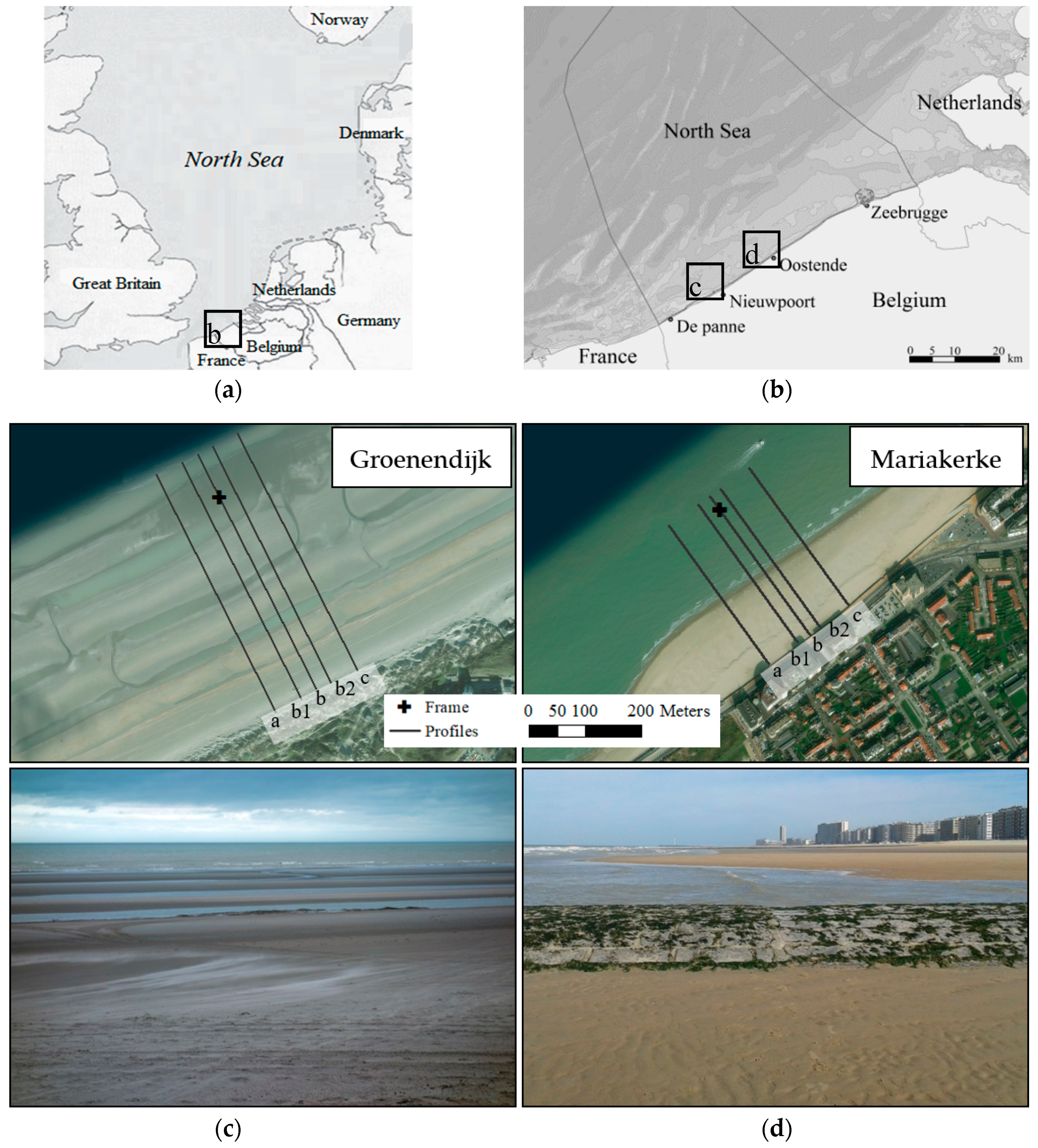
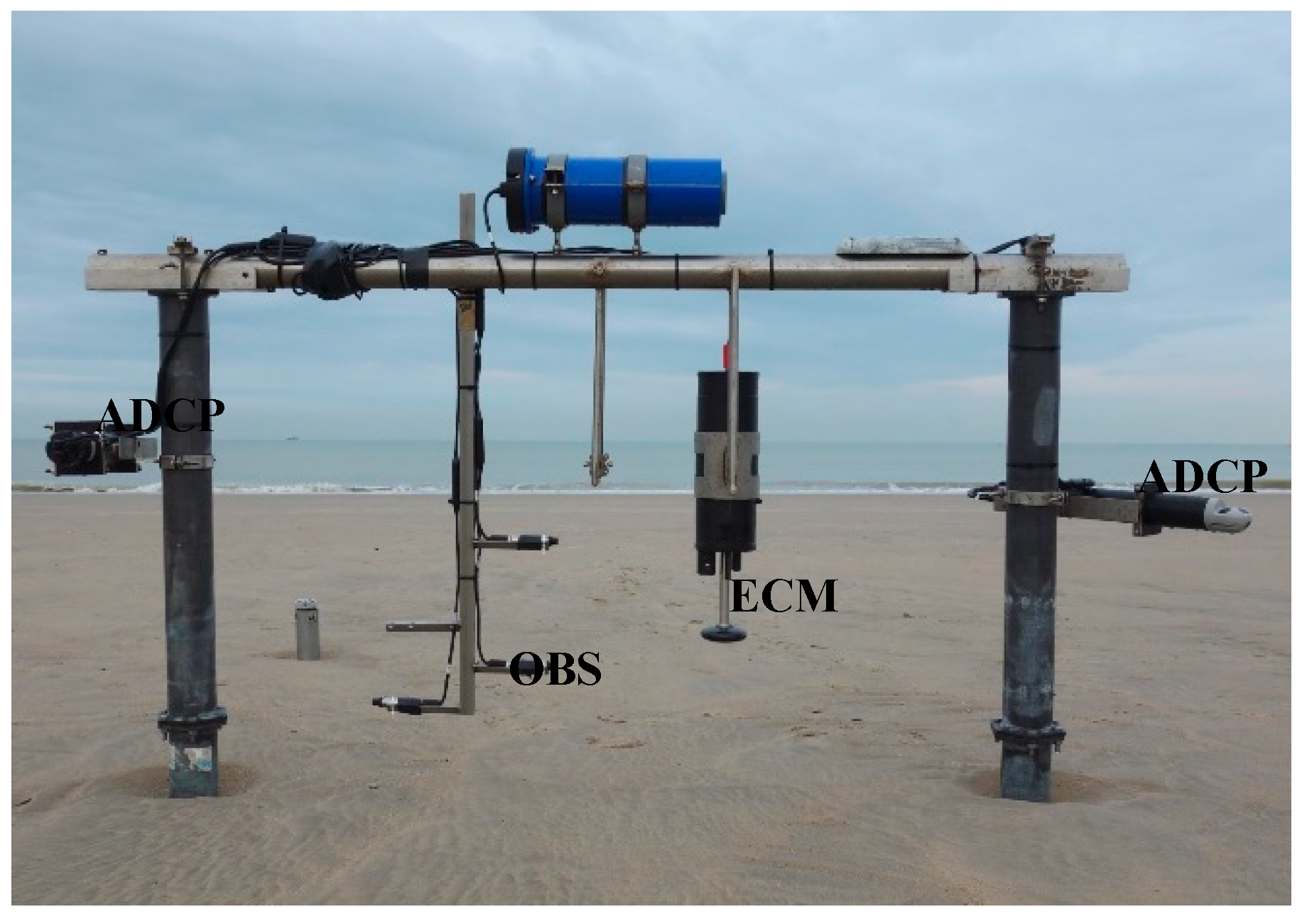
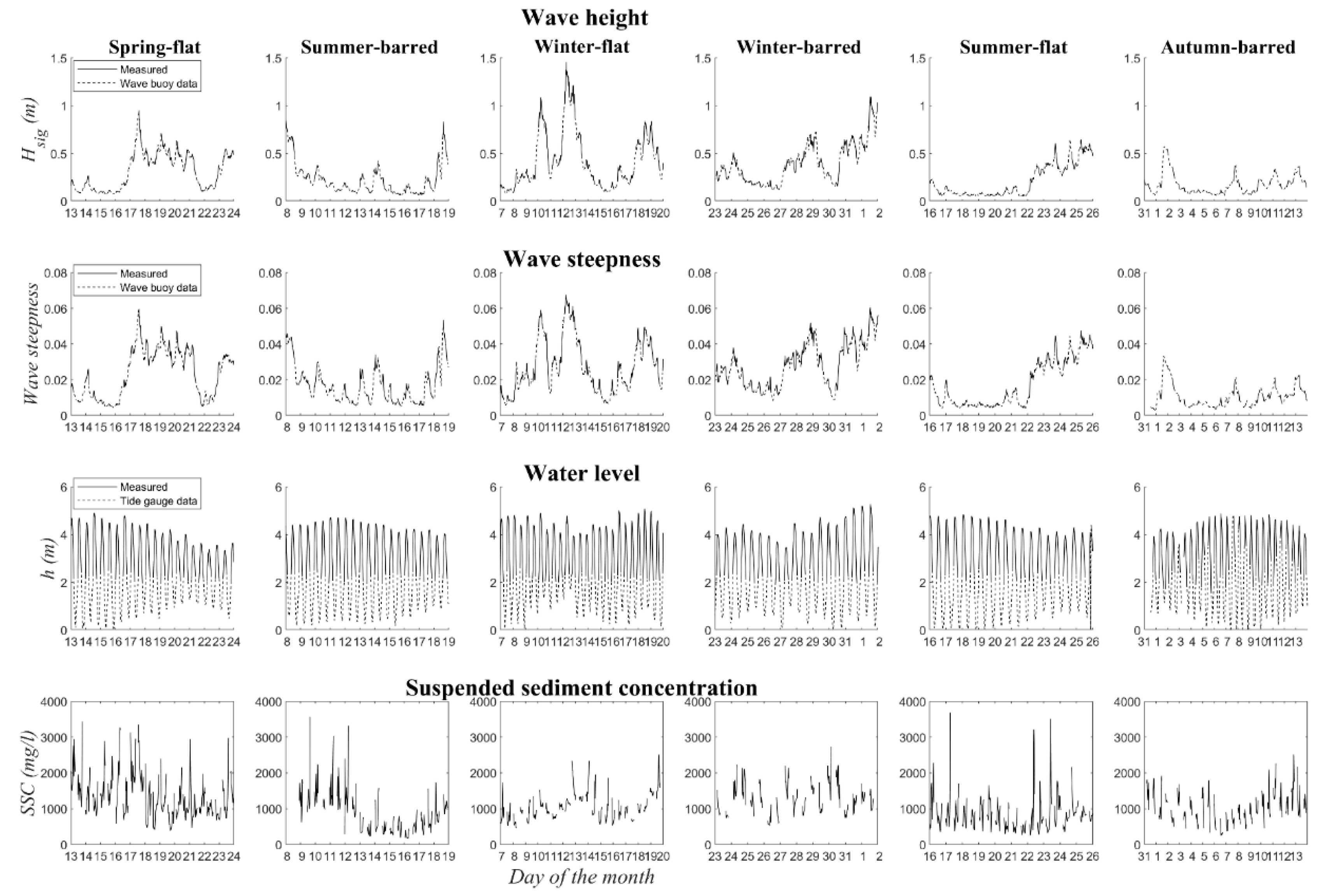
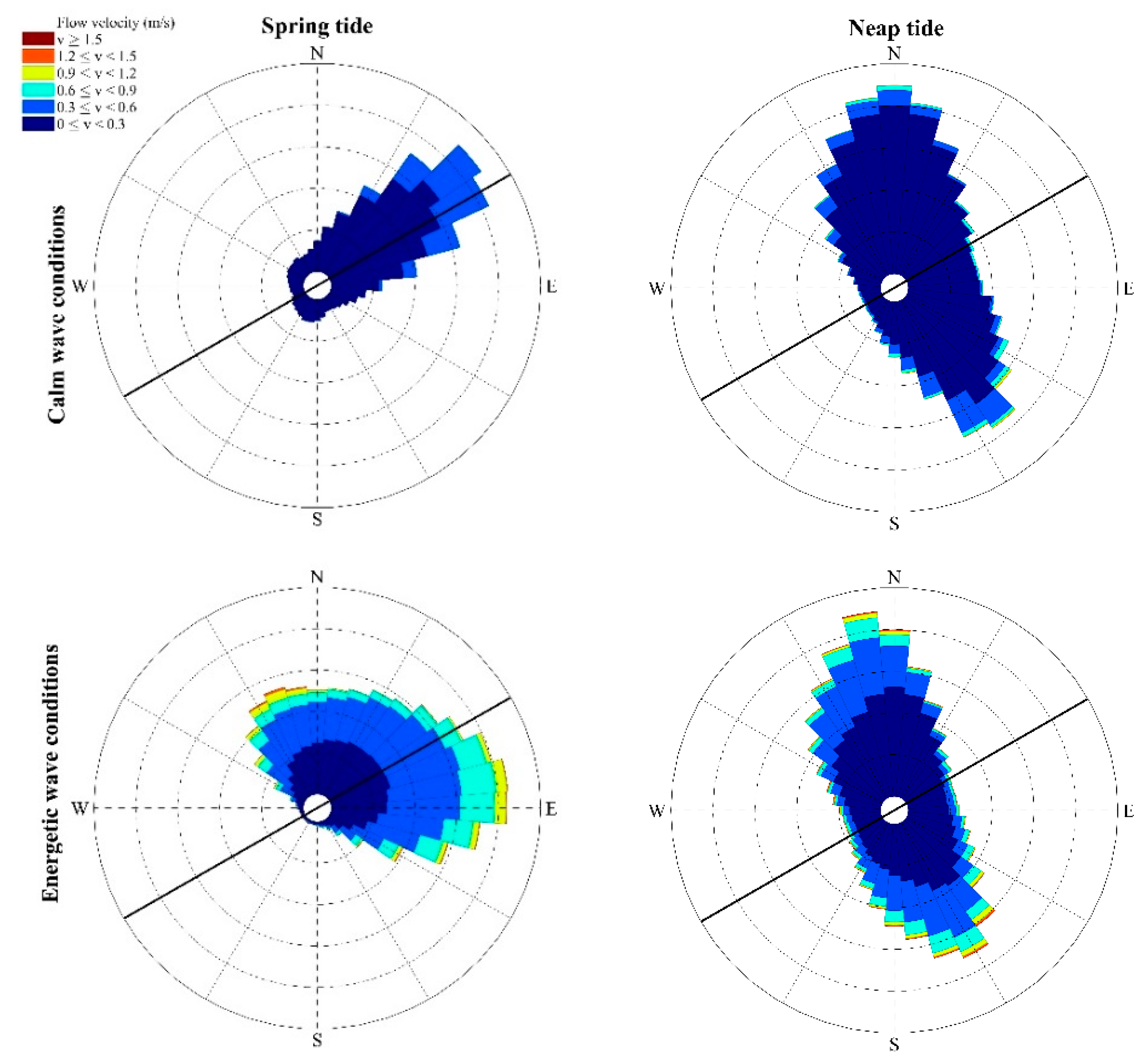
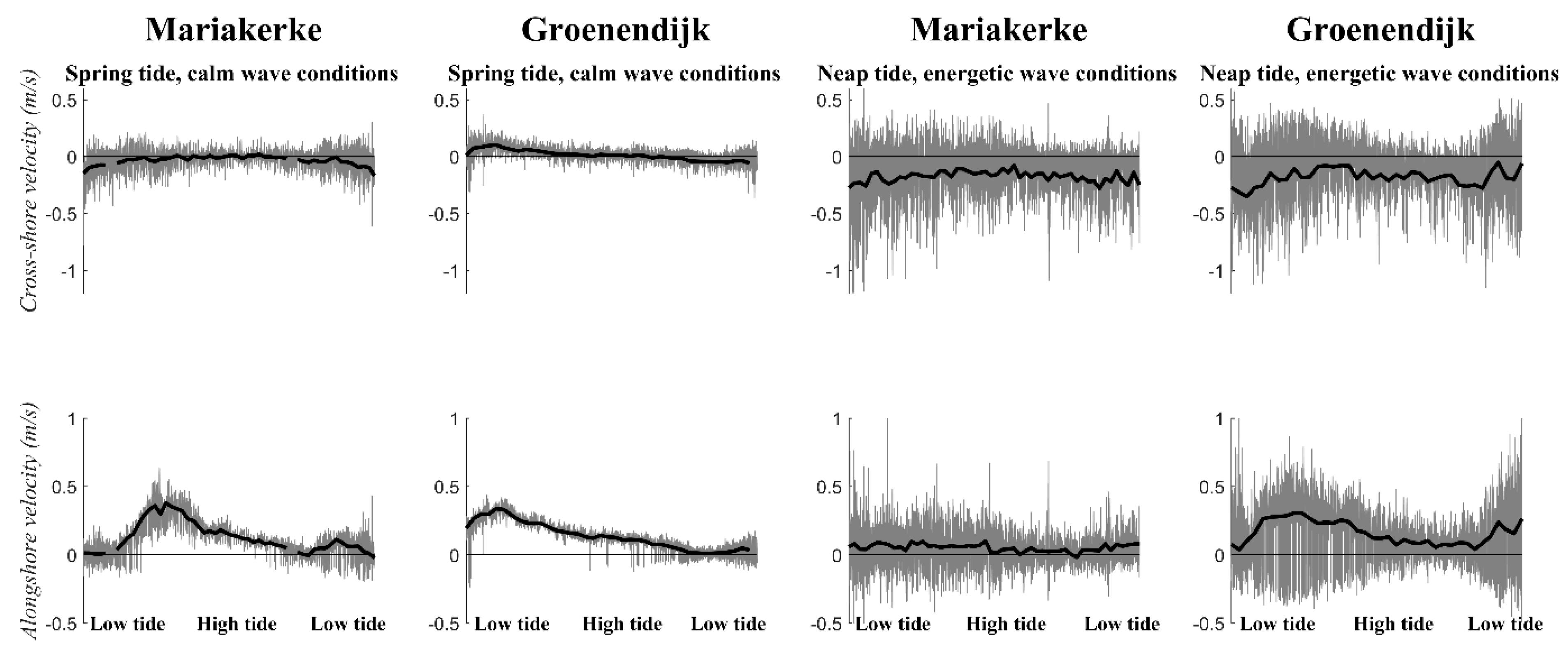

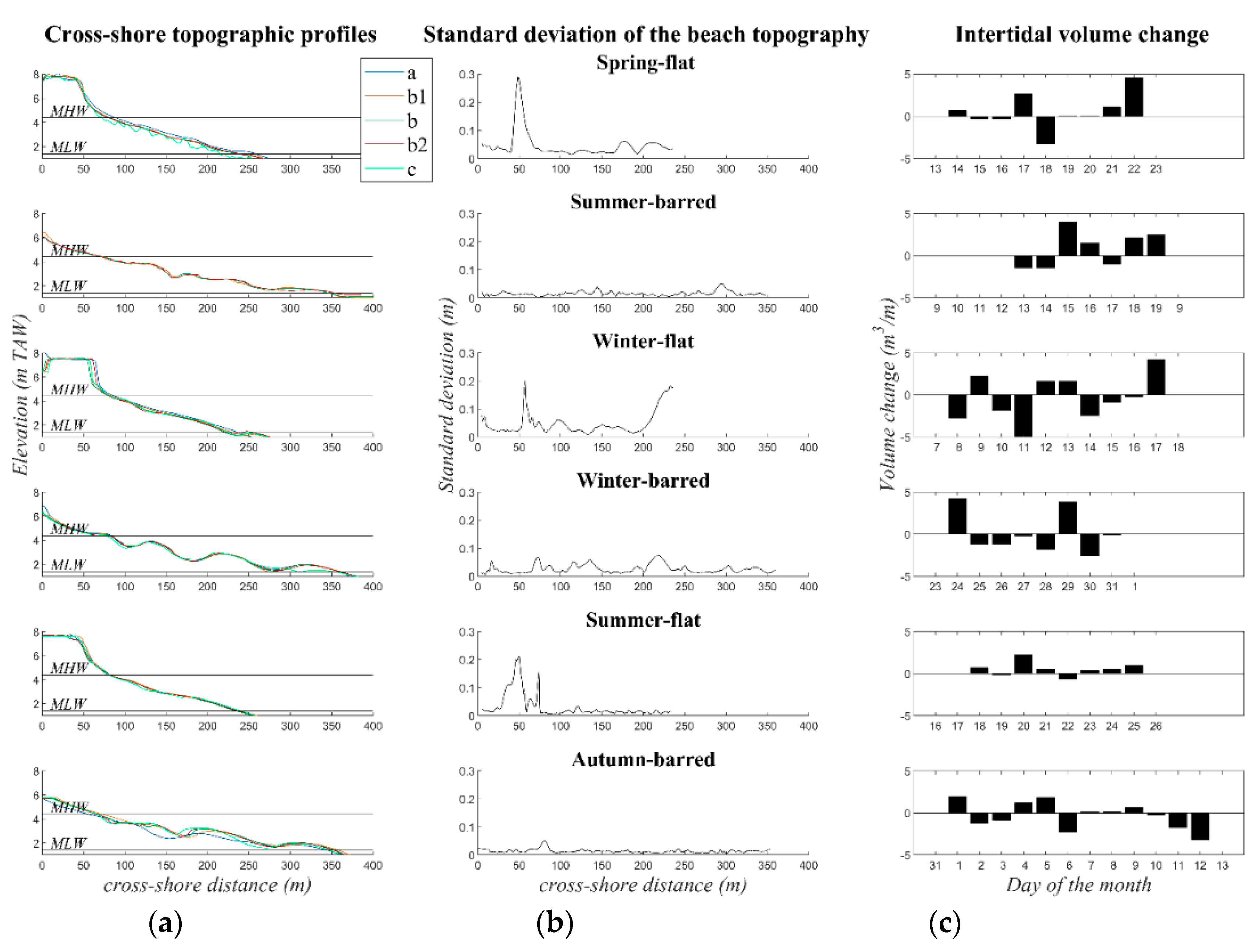
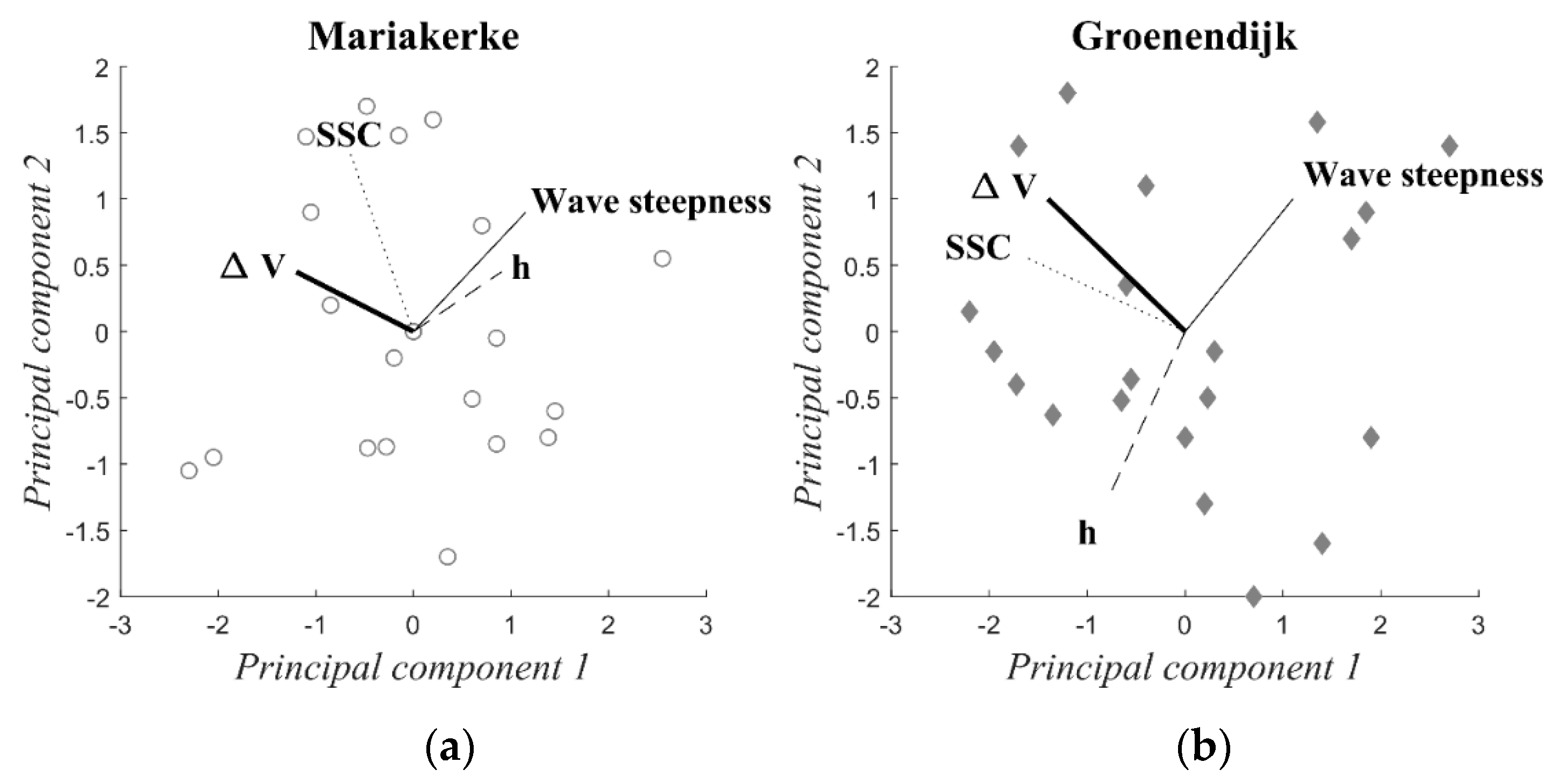
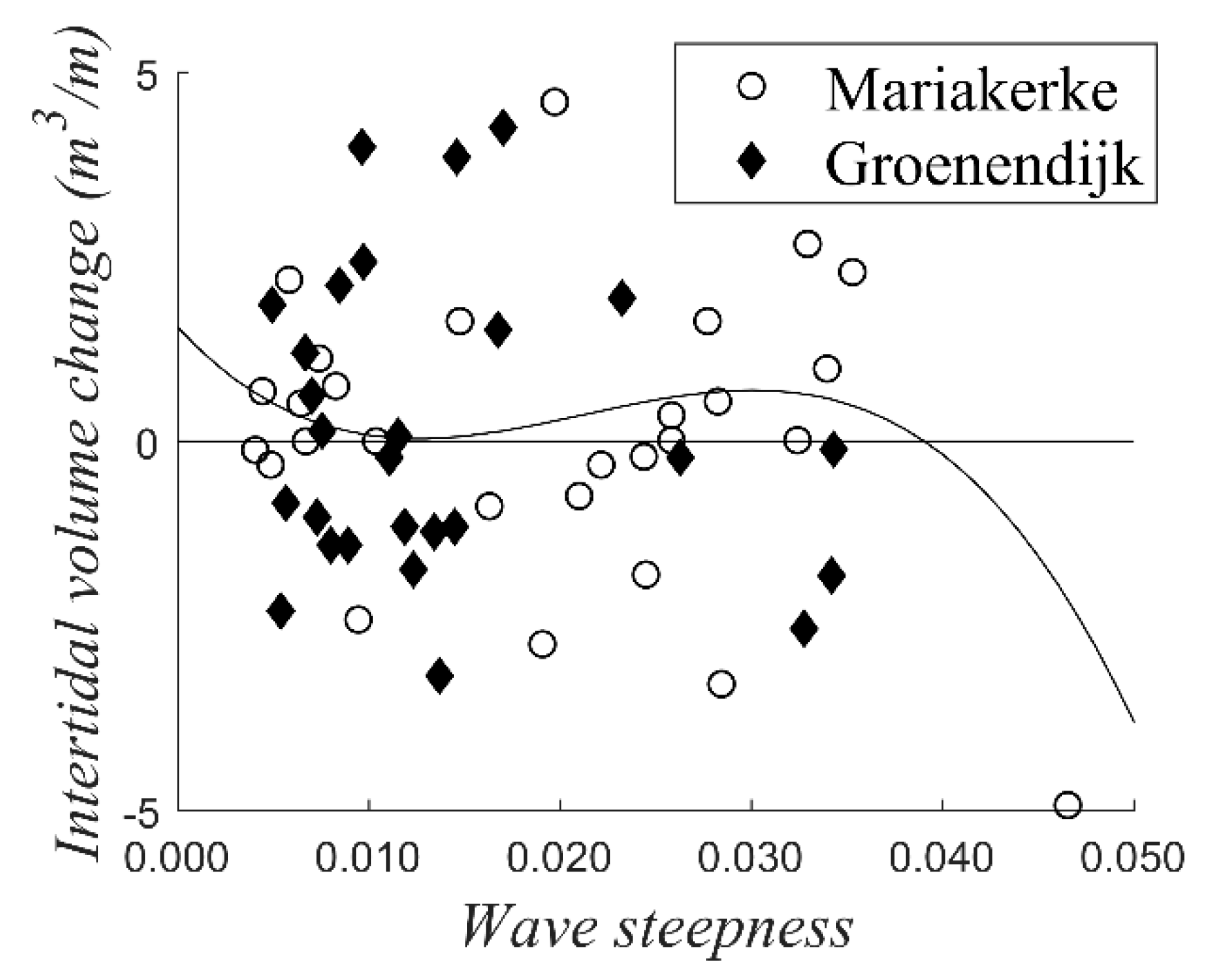
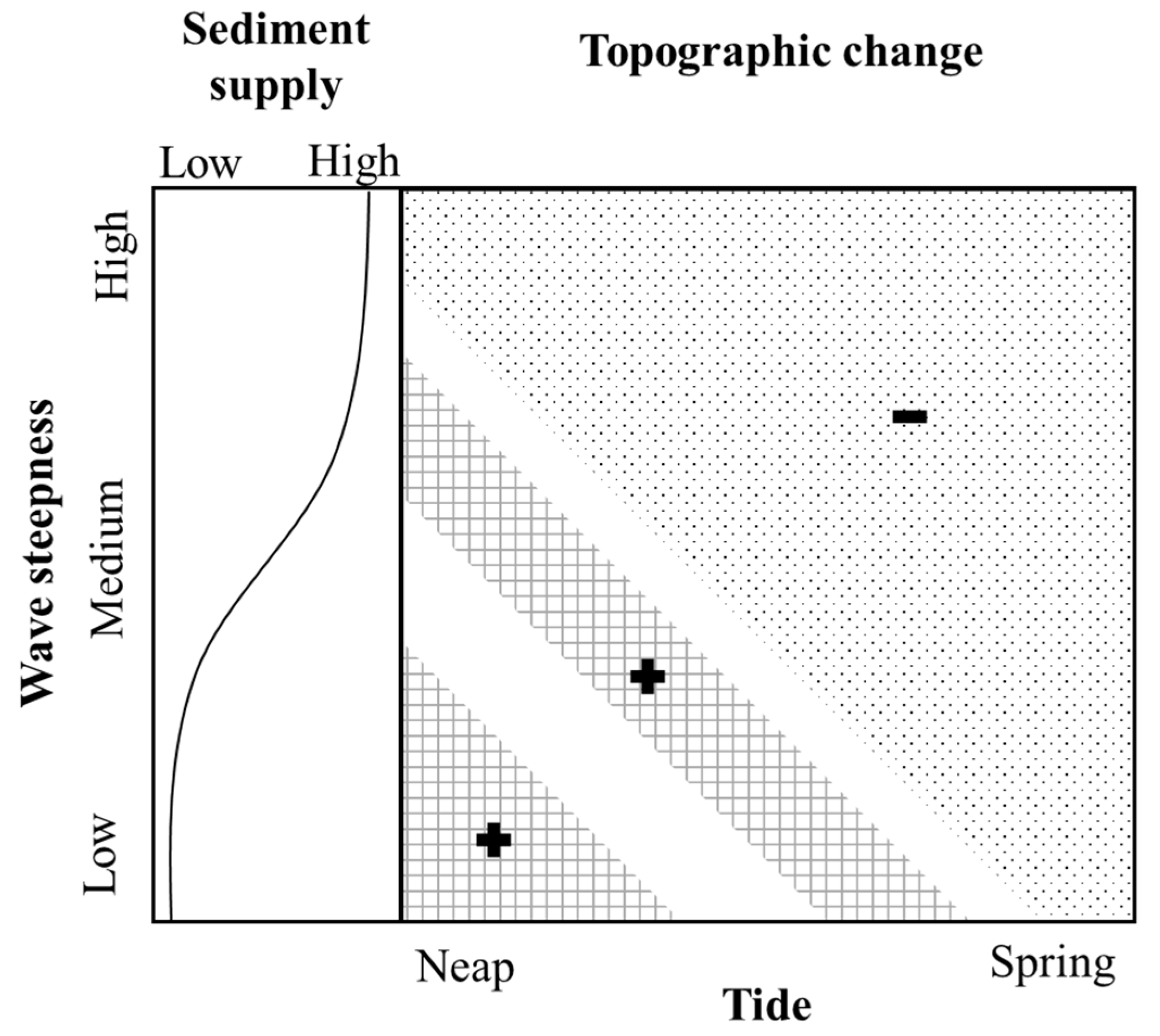
| Campaign | Location | Date |
|---|---|---|
| Spring—flat | Mariakerke | 13–24 March 2017 |
| Summer—barred | Groenendijk | 8–19 May 2017 |
| Winter—flat | Mariakerke | 7–20 November 2017 |
| Winter—barred | Groenendijk | 23 January–2 February 2018 |
| Summer—flat | Mariakerke | 16–26 April 2018 |
| Autumn—barred | Groenendijk | 31 October–13 November 2018 |
| Conditions | Spring—Flat | Summer—Barred | Winter—Flat | Winter—Barred | Summer—Flat | Autumn—Barred | |
|---|---|---|---|---|---|---|---|
| Wave height (m) | Avg. | 0.31 | 0.22 | 0.42 | 0.39 | 0.21 | 0.17 |
| Max. | 0.95 | 0.85 | 1.46 | 1.10 | 0.65 | 0.55 | |
| Wave steepness | Avg. | 0.024 | 0.018 | 0.028 | 0.028 | 0.018 | 0.011 |
| Max. | 0.059 | 0.054 | 0.068 | 0.060 | 0.048 | 0.028 | |
| Water level (m) | Max. | 4.91 | 4.72 | 5.09 | 5.28 | 4.84 | 4.88 |
| SSC (mg/L) | Avg. | 1325 | 733 | 1056 | 1275 | 839 | 1035 |
| Bed shear stress (N/m2) | Waves | 5.34 | 3.71 | 7.01 | 6.63 | 3.49 | 2.87 |
| Currents | 0.06 | 0.06 | 0.08 | 0.08 | 0.07 | 0.07 | |
| Conditions | Neap Tide (Max. Water Level < 4 m) | Spring Tide (Max. Water Level > 4 m) |
|---|---|---|
| Calm waves (steepness < 0.013) | 14% | 28% |
| Strong waves (steepness > 0.013) | 26% | 32% |
| PCA | Mariakerke 1st Principal Component | Groenendijk 1st Principal Component |
|---|---|---|
| Dominant current direction | 0.76 | 0.60 |
| Wave steepness | −0.43 | −0.54 |
| Maximum tidal water level | 0.49 | 0.53 |
| Percentage of variation explained | 54% | 62% |
| PCA | 1st Principal Component | 2nd Principal Component | ||
|---|---|---|---|---|
| Mariakerke | Groenendijk | Mariakerke | Groenendijk | |
| Intertidal beach volume | −0.60 | −0.54 | 0.26 | 0.52 |
| Wave steepness | 0.56 | 0.41 | 0.52 | 0.52 |
| Maximum tidal water level | 0.47 | −0.29 | 0.26 | −0.62 |
| SSC | −0.33 | −0.62 | 0.77 | 0.30 |
| Percentage of variation explained | 36% | 51% | 28% | 28% |
© 2020 by the authors. Licensee MDPI, Basel, Switzerland. This article is an open access article distributed under the terms and conditions of the Creative Commons Attribution (CC BY) license (http://creativecommons.org/licenses/by/4.0/).
Share and Cite
Brand, E.; Montreuil, A.-L.; Houthuys, R.; Chen, M. Relating Hydrodynamic Forcing and Topographic Response for Tide-Dominated Sandy Beaches. J. Mar. Sci. Eng. 2020, 8, 151. https://doi.org/10.3390/jmse8030151
Brand E, Montreuil A-L, Houthuys R, Chen M. Relating Hydrodynamic Forcing and Topographic Response for Tide-Dominated Sandy Beaches. Journal of Marine Science and Engineering. 2020; 8(3):151. https://doi.org/10.3390/jmse8030151
Chicago/Turabian StyleBrand, Evelien, Anne-Lise Montreuil, Rik Houthuys, and Margaret Chen. 2020. "Relating Hydrodynamic Forcing and Topographic Response for Tide-Dominated Sandy Beaches" Journal of Marine Science and Engineering 8, no. 3: 151. https://doi.org/10.3390/jmse8030151
APA StyleBrand, E., Montreuil, A.-L., Houthuys, R., & Chen, M. (2020). Relating Hydrodynamic Forcing and Topographic Response for Tide-Dominated Sandy Beaches. Journal of Marine Science and Engineering, 8(3), 151. https://doi.org/10.3390/jmse8030151





